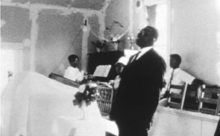Article, "Like A River Flowing With Living Water; Worshipping in the Mississippi Delta," by Joyce Marie Jackson
"Like a River Flowing with Living Water": Worshiping in the Mississippi Delta
By Joyce Marie Jackson
In the view of many people, the American South is a complex phenomenon. One aspect of its complexity is that cultures brought there from Africa and Europe interacted with one another despite efforts to keep them separate, and so African Americans and European Americans have assimilated to a certain extent, and adapted similar religious traditions. Yet, though some congregations are now integrated, especially the Full Gospel churches, religious life in the South continues to be divided along racial lines. The assertion that 11:00 a.m. on Sunday morning is the most segregated hour in American society is probably as valid today as it ever was. However, the segregated nature of Southern religion is one that African Americans and other ethnic groups chose, in order to worship not only with a sense of dignity and independence but also in their own style.
This article attempts to examine briefly the richness and diversity of worship experiences in the Mississippi Delta. Looking at oratory, music, ritual, and sacred spaces also helps us understand what Anglo- and African-American sacred folk traditions have in common and where they differ.
Singing the Word
The tradition of Southern oratory includes roaring campaign speeches from the back of a pickup truck as well as "fire and brimstone" preaching at a backwoods church revival. The central figure in the religious oratory folk community is the preacher. An indispensable part of his art and skill is to be able to respond to, engage, and raise spiritual energies during the performance of a sermon without a written text.
Where the sermon was first chanted, and by whom, is very difficult to determine. Bruce Rosenberg places the background of present-day fundamentalist beliefs and the chanted spiritual sermon in the 19th century by relating them to the Second Great Awakening of 1800-1801. Certainly the Great Awakening ushered in the age of the informal folk preachers in America and did much to modify the image of the clergy. In fact, the clerical profession in general has not been the same since the spiritual services took to the brush arbors and camp meetings.
It is probable that the Great Awakening provided African-American preachers their first significant public exposure; however, their preaching style and long, colorful, narrative prayers had been developed earlier, during the institution of slavery. The chanted sermon style—once held to be altogether European in origin—has historic precedents in several West, Central, East, and South African groups. Because many African cultures emphasize oral tradition, the artful manipulation of "the word" (from precolonial epics of the West African griot to playing the dozens or rapping in the streets) is a highly prized skill among people of African descent. Although both African Americans and Anglo Americans perform the folk chanted sermons—and may go beyond chanting to actually singing—the tradition has been most fully developed in the African-American community.
Timing is a vital factor in the building of the sermon, which normally begins in prose and moves into metrical verse. The rhythm of the lines must be properly maintained throughout the performance for it to be effective, and the congregation's response, often in terms of call-and-response, plays a key role in the rhythmic structure of the sermon. The preacher's individual style—his preference for particular melodies, rhythms, formulaic expressions, and themes—continually recreates the tradition.
Songs of the Spirit
Another important aspect of worship is, of course, music. Spirituals, the sacred folk songs created by enslaved African Americans during the ante-bellum era, are still being performed in their traditional a cappella (unaccompanied) style in many rural African-American churches. Urban churches have added piano accompaniment as well as other forms of instrumentation, and spirituals have also been arranged as gospel songs.
Although Anglo- and African-American Baptists in the Delta rarely share their pews, they do share some of their hymns. Common to both churches is the lining-out style of the Dr. Watts and other long-meter hymns (Dr. Isaac Watts was an 18th-century English Methodist hymn writer).
Lining-out is a hymn-singing tradition that arose out of necessity. There was a lack of hymn books and an abundance of people who could not read; therefore, one person was designated to 'pitch' the song for the whole congregation. Both African and Anglo Americans practice this tradition in different performance styles. In the Anglo tradition the congregation sings almost the exact melody and rhythms of the leader, with some variation from individual singers; in the African-American tradition, the lead voice and congregation overlap melodically and rhythmically and decorate the hymn tunes with various vocal embellishments and moans. This produces an extraordinary effect sometimes called surge singing. In many churches this style is still performed a cappella.
Another style of religious music still prevalent today in the Delta is sacred harp, in which a system of four shapes—a triangle, circle, square, and diamond—is employed to designate the musical syllables fa, sol, la, and mi (shape-note singing is also called fasola singing). This system, a popular and effective way of teaching people to "read" music, was an outgrowth of the New England singing school movement and the Great Awakening. Published in Philadelphia in 1801, William Little's The Easy Instructor, or A New Method of Teaching Sacred Harmony introduced the shape-note system to the general public. Later in the 19th century the publication of books employing the shape-note system began to spread south. William Walder's Southern Harmony (1835) and Benjamin White and B.J. King's The Sacred Harp (1844) have been two of the most widely used.
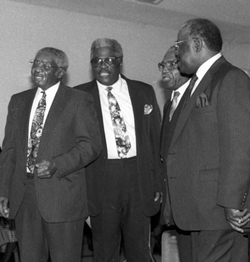
Convention Specials. Photo: Susan Roach.
The Anglo-American sacred harp singing conventions that take place in the Delta are usually all-day affairs, and everybody is expected to participate in these religious social events. What follows the singing is another tradition—"dinner-on-the-grounds," a communal feast contributed to by all participants. Most of the singing is still done a cappella with the hymns sung first using the "fasola" syllables.
Although shape-note singing has been called White spiritual and White gospel singing, the system was adapted by certain African-American congregations in the South during the 1880s using texts of songs drawn from old hymns, gospel songs, and a few spirituals. There is only one collection of African-American sacred harp compositions, The Colored Sacred Harp (1934) by Judge Jackson.
The African American Shape Note and Vocal Music Singing Convention Directory for Mississippi and Areas of Northeast Alabama was published through the efforts and coordination of Chiquita Willis to "foster and support a network of African-American shape-note music singers and supporters that will facilitate interaction among conventions." In August 1993, nearly 300 people, including delegations from twenty different singing conventions, attended the two-day West Harmony Singing Convention held at Pleasant Grove First Baptist Church in Grenada County, Mississippi. This convention and the work of Chiquita Willis have demonstrated that Mississippi has a much larger, more widespread shape-note tradition than previously thought.
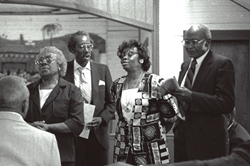
Winnsboro Shape Note Singers at Gallilee Baptist Church. Photo: Susan Roach.
Among the various African-American shape-note singing groups in the Louisiana Delta area are the Winnsboro Senior Citizen Singers and Mr. and Mrs. Orland Johnson, a singing couple from Start, Louisiana. They participate along with other groups, most of whom sing a cappella, in the parish-wide, state, and regional convention and singing schools.
The shape-note singing conventions also led to the formation of some a cappella gospel quartets. The Oldham Family from West Carroll Parish in Louisiana is an English/Scots/Irish quartet that sings hymns learned in shape-note singing schools with the newer seven-note shape-note system.
A number of African-American quartets in the Delta started with the shape-note system as well. The Pleasant Star Singers (formed in 1946), one of the oldest a cappella quartets in the Winnsboro, Louisiana, area, still sing with the singing conventions. The Convention Specials Quartet (with members from various Delta parishes), the Mighty Soul Guides, and the Royal Newtown Spiritual Quartet from Monroe can usually be found at church programs and quartet anniversaries.
Gospel music has contributed tremendously to the Mississippi Delta region's unique musical heritage. This new sacred music of the 20th century reflects the concerns of urban life and to a large extent has replaced other sacred styles like the folk spiritual and the Dr. Watts hymn. In the African-American community during the 1920s the gospel tradition began to emerge in small, urban, Pentecostal "storefront" churches, then gradually in Baptist churches. Now the genre has found its way into the sanctuaries of African-American congregations of virtually every religious denomination, including Catholic.
When Anglo-American settlers moved into the Delta, they brought with them their fiddling, ballad-singing, and sacred music traditions. Their gospel music can be found in performances of gospel quartets, family and community groups, and country and bluegrass bands. Many of these styles are rooted in the shape-note singing tradition.
Though country and bluegrass music differ in their themes and instruments, bands from both genres usually perform sacred songs. You can also find an occasional sacred instrumental band in the Delta. Rev. Gerald Lewis, who grew up in Ferriday, Louisiana, plays gospel piano in his Pentecostal Band and built a ministry in several rural churches in Swartz, Louisiana. His cousins Jerry Lee Lewis, Mickey Gilley, and Jimmy Swaggart took that small-town background and musical skill to the top of the rock and roll, country, and television evangelism fields.
Sacred Rituals
Rites of passage such as birth, death, and marriage mark a change in a person"s socioreligious position. Baptism in the Delta region, a symbolic ritual of purification and initiation, is a significant rite of passage. As late as the 1950s, river submersion was common in both African- and Anglo-American Protestant churches but continues today primarily among African Americans.
Nowadays, after their week-long annual revival, Rev. L.D. Oliver, pastor of St. Paul Baptist Church in Monroe, Louisiana, and Rev. Roosevelt Wright, Jr., pastor of the Tabernacle Baptist Church, gather their congregations together for the river baptism. In this setting the old, traditional spirituals such as "Take Me to the River," "I Know I've Got Religion," and "Wade in the Water" are sung. Rev. Oliver works to remind other area ministers and youth about their heritage of river baptism from the biblical example set by John the Baptist baptizing Christ in the Jordan River.
Rituals involving immersion in bodies of water are also prevalent in traditional African religious ceremonies. They are symbolic of purification, washing away evil and healing the physical as well as the spiritual being. The ritual act of immersion carries the hope of renewal and freedom, ideas that have driven African-American spirituality.
The ministers in Rayville and Alto still take their congregations to the nearby Beouf River, and in Monroe the Ouachita River at the Foot of Pine Street has been used for several generations. This sacred place is called by the elders of the community the Old Burying Ground, an appropriate name for the place of ritual baptism in which "the candidate is symbolically buried in Christ, sins are washed away, and one is raised up to walk in newness of life."
Another sacred ritual that takes place in rural African-American Baptist churches in northern Louisiana is the Easter Rock ceremony held on the eve of Easter Sunday. In this ritual the elders sing some of the old traditional spirituals such as "Oh, When the Saints Go Marching In" and "King David." The songs are sung in a chant-like manner, as the participants move counterclockwise with circular rocking movements around a table placed in the middle of the church floor. Dr. Watts and other long-meter hymns such as "I Know the Lord Will Answer Prayer" and "I Love the Lord, He Heard My Cry" are also very prominent in the context of the Easter Rock. The congregants dress in white, and the leader carries a circular banner representing the cross. The table is decorated with white tablecloths, and twelve lamps and twelve cakes, representing the twelve disciples and twelve tribes of Israel. The Easter eggs on the table symbolize new birth,
This ritual clearly has African and Caribbean antecedents; there are many accounts of sacred circular dances throughout the African diaspora. Some of the elderly Delta participants recalled their parents remembering the tradition as pre-dating the Civil War. The "rock" had vanished for awhile, then certain individuals became interested in the history and began to revive the tradition. The ritual has been passed on by the Addison family for many generations. Now Hattie Addison coordinates the Winnsboro Easter Rock, and people from various congregations in the area participate. The Original True Light Baptist Church, pastored by Rev. J.L. McDowell, is ideal for the "rock" because its wooden floors contribute to the percussive effect, and movable pews make room to "rock" in a circle. The whole ceremony is done a cappella; only hand clapping and foot stamping accompany the songs. Easter Rocks were once held around Ferriday, Louisiana, in Clayton and Sicily Island; however, those have not been organized in the last few years.
Spiritual Spaces
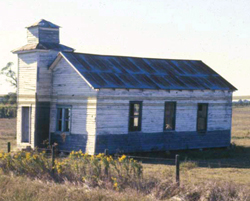
Church in Concordia Parish. Photo: Pete Gregory.
The religious experiences of many people are tied to specific places where rituals are performed. Some people also construct personal sacred space to their own specifications.
On Old U.S. 61 in Kings, Mississippi, just outside of Vicksburg, one man's sacred space has been under construction for several years. Rev. Herman Dennis is spreading the word of God not only through his spontaneous sermons but also through his craftsmanship.
Dennis has decorated Margaret's Grocery Store (belonging to his wife) in red and white brick with large brick columns of varying size. All bear bits and pieces of biblical phrases and messages that travelers can read. He has also placed reproductions of various symbolic designs in very strategic places. For example, on the wall, ceiling, and the sidewalk he has placed the Masonic order symbol of the "G," which to him represents God.
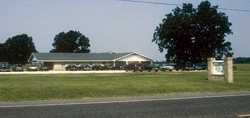
Memonite Church in Lake Providence. Photo: Susan Roach.
To the right of the grocery store is a large brick tower where he plans to house the Ark of the Covenant, which will eventually contain the Ten Commandments. Then, he believes, Margaret's Grocery Store will attract people of all Christian faiths to worship. Dennis believes that God, like himself, is a builder or a "craftsman." "The Almighty is the greatest architect," he says, :"and I am his assistant."
These genres of worship in the Delta constantly reunite a region by reminding it of its shared but multifocal heritage. Worship traditions are shaped by a collective and selective memory. Decisions are made by regarding fundamental and shared values. To participate in traditional worship traditions is to relive that past and to make it a source of power for the future of the Delta.
Works Cited & Suggested Reading
The African American Shape Note & Vocal Music Singing Convention Directory: Mississippi and Areas of Northwest Alabama. 1994. Mississippi Folklife 27.
Davis, Gerald L. 1985. I Got the Word in Me and I Can Sing It, You Know: A Study of the Performed African-American Sermon. Philadelphia: University of Pennsylvania Press.
Ellington, Charles Linwood. 1969. The Sacred Harp Tradition of the South: Its Origin and Evolution. Tallahassee: Florida State University.
Jackson, Joyce Marie. 1995. The Changing Nature of Gospel Music: A Southern Case Study. The African American Review 29 (2):185-200.
_____. 1981. The Black American Folk Preacher and the Chanted Sermon: Parallels of a West African Tradition. In Discourse in Ethnomusicology II: A Tribute to Alan P. Merriam, ed. Caroline Card et al. Bloomington: Ethnomusicology Publication Group.
Jackson, Judge. 1992. The Colored Sacred Harp, For Singing Class, Singing School, Convention and General Use in Christian Work and Worship. Montgomery, Alabama: Brown Printing.
Olsen, Ted. 1991 and 1992. The Voices of the Older Ones: The Sacred Harp Singing Tradition in Calhoun County, Mississippi. Mississippi Folklore Register 25 and 26.
Rankin, Tom. 1993. Sacred Space: Photographs from the Mississippi Delta. Jackson: University Press of Mississippi.
Rosenberg, Bruce A. 1988. Can These Bones Live?: The Art of the American Folk Preacher. Urbana: University of Illinois Press.
Staten, Annie, and Susan Roach. 1996. Take Me to the Water: African American River Baptism. In The Louisiana Folklife Festival Program Book. Monroe: Louisiana Folklife Festival.
Sturman, Janet. 1993. Asserting Tradition: Building and Maintenance of African-American Baptist Rock Ceremony in Northeast Louisiana. Louisiana Folklife 27:24-32.
Suggested Listening
The Five Blind Boys of Mississippi. The Best of the Five Blind Boys. MCA 28022.
_______. Precious Memories: A Tribute to Archie Brownlee. MCA 28002.
The Hawkins Family. Oo-wee Lord, You Have Been Good. LILSIL+s Music, Dallas, Texas.
Hemphills. Home Cookin'. Heart Warming.
Hunter Brothers. 1995. The Ship. DDS.
Lewis, Jerry Lee. In Loving Memories: The Jerry Lee Lewis Gospel Album. Mercury SR61318.
Mississippi Sacred Harp Singing. Southern Folklore 101.
The Pilgrim Jubilees. The Old Ship of Zion. MCA 28010.
Racy Brothers. 1996. Time Out. Ace.
Smith, Mother Willie Mae Ford. Mother Willie Mae Ford Smith. Spirit Feel 1010.
The Southern Harmoneers. He'll Make a Way. Hot Productions, Inc. HTCD 3701-2.
Swaggart, Rev. Jimmy. The Golden Gospel Piano. Jim R3607.
Tharpe, Sister Rosetta. Gospel Train. MCA 1317.
Joyce Marie Jackson, an ethnomusicologist and folklorist, is Associate Professor in the Department of Geography and Anthropology at Louisiana State University in Baton Rouge. This article was written for the 1997 Smithsonian Folklife Festival which featured the Mississippi Delta of Tennessee, Arkansas, Mississippi, and Louisiana from Memphis to Natchez. The Smithsonian Center for Folklife and Cultural Heritage presentations were one component of the multi-year Delta Folklife Project. The essay was revised in 2012 for publication of Delta Pieces: Northeast Louisiana Folklife.
